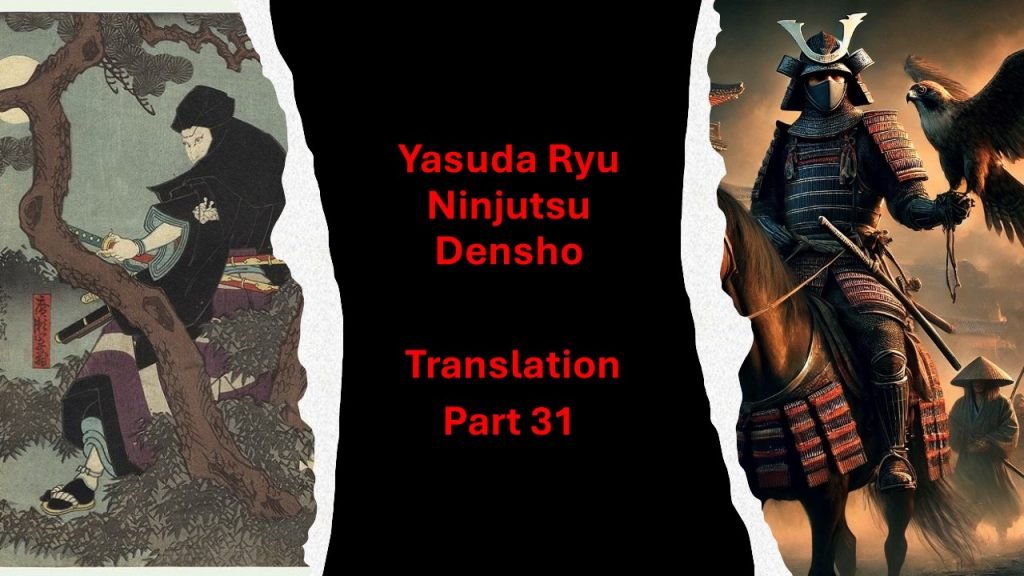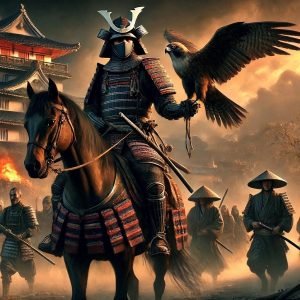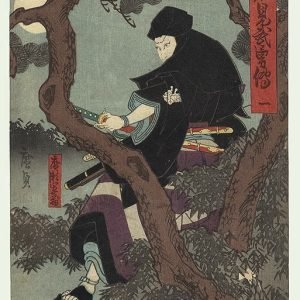I’d like to start this blog with an apology, as it’s been nearly a year since my last post. Life and a demanding work schedule took priority, but I’m making an effort to return to writing and translating more regularly. Thank you for your patience.
Continuing with the Yasuda Ryu ninjutsu densho translation, please keep in mind that this is the very first ninjutsu densho Hatsumi Sensei received from his teacher, Takamatsu Sensei. Though this document isn’t directly tied to the Ryu-ha of the Bujinkan Dojo, it offers a vivid look into the nature of ninjutsu as it was practiced in the mid to late 1800s, before Japan’s opening by Commodore Perry and the United States. While many historians suggest that ninjutsu had faded by the late Edo period, this document demonstrates the art was still very much alive, with knowledge being meticulously transmitted.
This section of the densho details how, in ancient warfare—particularly in mountainous regions—strategy and stealth were crucial for success. The art of placing tools along mountain paths was a highly specialized skill, refined over generations and passed down through secret teachings. Here, the Yasuda Ryu densho delves into the nuances of this practice, highlighting techniques used by infiltrators to effectively conceal their tools, evade detection, and outmaneuver their opponents. It underscores the importance of terrain, weather, and timing in choosing ideal locations for tool placement, as well as the careful planning required to ensure successful covert operations.
Here is the translation of the chapter:
◎About placing tools on mountain paths
山道の置道具の事
– When the enemy has a castle on the mountain, there are usually two or three paths to climb. Since these are enemy paths, you must know the length, width, bends, slopes, descents, whether there are trees, rocks, or soil, and conditions such as rain, snow, wind, morning, noon, night, full moon, half moon, dark nights, mist, slippery surfaces, and the presence or absence of water. Though one may be familiar with all of these, tools should not be placed directly on the enemy’s path. However, placing them outside the path makes them hard to find, so the decision on where to place the tools should be made based on the thoughts and movements of the infiltrator.
一、敵の城山にあれば登る道二、三本なり。 この道は敵の道なれば、長さ、幅、曲り、坂、下り、木のありなし、岩、土の事、雨、雪、の時、風、朝、昼、夜、満月、半月、闇夜、霧、滑り、水ありなし、 □う全部と申しても、よきほど知っているものにして、置道具をこの敵の道に置くものでなし。されど道の外に置けば、捜しにくし。されば置道具の事。忍行く者の考えと動きによって決める事。
– Once the tools are placed, do not return the same direction you came in. If your movements are sloppy, you may be found. This is often the case. Understood?
一、置道具を置き帰り、また忍行来べからず。その姿を、うさくなり、見付けられし事ままあり。よいな。
– Climbing outside or around the usual path may be preferable, but moving through trees, rocks, bamboo, or other vegetation may cause noise and increase the risk of being discovered. Special caution is needed when moving such objects.
一、道以外の所を登り、忍ぶはよけれども木、岩、笹、竹、などの中を登り下りするものなれば、擦れ合う音にて見付けられる恐れ多し。またその物の動きにてもあり特に用心の事。
– However, it is advantageous to move during a strong storm, though it may also be difficult to hear or see the enemy’s movements clearly. Be cautious not to make mistakes.
一、されど嵐の強き時よし。ただし敵の動き、音、等は見聞きにくき時ままあり。 不覚を取らぬ事。
– When the wind is strong, the enemy will be on guard against fire, making stealth difficult. Pay attention to this.
一、敵風強き時は、火の用心をするものにして、忍にくき時あり。気を付ける事。
– It is advisable to measure the number of steps from the corner or edge of the enemy’s stone wall before placing the tools.
一されば置道具は、敵の城の石垣のすみ及び角より足数を決めおくがよし。
– The tools should not be visible from within the castle’s point of view (although this may vary depending on distance, or during the night).
一、城内よりは見えぬものなり(遠眼なれば、しかし夜なり)。
– Wrapping the tools in oiled paper and sinking them in a moat with a string attached is also a good idea. If oil floats on the water, camouflage it with floating grass or similar materials.
一、堀の中に油紙に包み、紐を付け沈めるもよし。水面に油の浮くものなれば、浮草等を浮かすもよし。
– When acting alone, consider the terrain, distance, brightness, and the season (spring, summer, autumn, winter) when planning your stealth. Always keep in mind that being followed is the worst mistake an infiltrator can make. If you are followed, you are unqualified to be a shinobi-no-mono. However, being human, such things happen. In such cases, you must either kill your pursuer or, if possible, lose them along the way. Killing the enemy is often a foolish strategy, as it will leave evidence.
一、一人出の時地の形、距離、あかるさ、春、夏、秋、冬、どの時に忍ぶかと思う事。 この事を頭に入れて動く事。敵に付けられると申すのが第一の不覚なれば、この者は忍の者としての資格なし。されど忍ぶ者といえども、これ人也。しかたなし。されば付けて来る者を殺すか、 出来れば、道にてはぐらかすべし。敵を殺さば、しつこく御手が付く物なれば、愚策なり。
– Losing the enemy on the road is the best option. At night, it may be easier, but during the day, when long-distance vision is effective, it is more difficult. If you flee to a town and use a house, escape through the back. But if the enemy has two or three people, they may be watching the back as well, so be careful. If possible, disguise yourself as a different person.
一、道にてはぐらかすを上とする夜なれば、その苦労はなけれど、昼などにては遠眼がきくものにして、はぐらかしにくし町に行家を使い、裏に抜けるべしなれど、敵の者二、三名なれば、裏にも見張りあり。用心の事。 出来れば姿を替えるが上策なり。
– If the enemy has secured the entrance and exit of the town, it may be impossible to escape by normal means. Wait for nightfall and plan accordingly.
一、敵、町の入口出口を固めるものにして、普通の事では出られないと思えばよし。夜を待つべし。この事を考え、動く事。
– Disguising yourself as the enemy is the best strategy. This technique is passed down orally.
一、敵の者の姿になるが第一によし。口伝あり。
– It is best to remain unseen by the enemy.
一、敵に姿を見られぬがよし。
– When infiltrating, it is acceptable for two people to leave from the same place, but any additional people should change locations.
一、忍に出る時は、同じ所より二名まではよけれども、その後の者は出来れば場所を替えるを本とする事。 この事を心に〆め動く事。
◎Concerning tools buried in the ground:
道具の事(土に埋める道具)
– After burying the tools, do not place small branches on top. If someone steps on it, the ground will feel soft and may be discovered. Make sure the ground looks the same as the surrounding area, and place a guiding thread beneath the soil.
一、土に埋めし後、小枝を乗せるべからず。上を踏むとふわふわするもので、見出される事ままあり。 その付近の地形と同じにして、その上に置糸を置き、土を被せる事。
– When retrieving the tools, pay close attention to the shape of the guiding thread. If it remains in the same shape as when it was buried, it is fine.
一、掘り出す時は、この置糸の形をよく見る事埋し時の形のままなれば、よし。
– If the enemy finds the site, they will not recognize the guiding thread at first, but if they dig it up, check whether the shape of the thread has changed. If it has, leave the tools there and quickly retreat.
一、敵より見出されし時、置糸があるとは思わず、掘るものなれば、糸の形が変っていないかを確かめる事、変っていたならば、その置道具はそのままにし、その場より早く早く散る事。これ第一なり。
– Always assume the enemy may be staking out the location to capture you.
一、敵我を捕えるため、張り込みありと思う事。
– The guiding thread should be laid in the form of characters from the Iroha poem.
一、置糸の形は、イロハ作りに置く事。
– The method of creating the Iroha form is passed down orally. Shinobi-no-mono would use string to form the characters of their favorite symbols above the buried tools, and then cover them with soil. This string technique is a great secret for concealing tools.
一、イロハ作りの口伝。忍者のすきなる字を置道具の上に紐で作り、その上より土を被せる事、この紐の事、置道具の大秘事なり。
– If it rains, no matter how firmly the soil is packed, the spot will sink, so take care.
一、雨降れば、いかに固く土を埋めたれど、その所凹むなれば、気を付ける事。
– During heavy snow or snowfall, the tools are harder to find, so plan accordingly. Be careful not to panic and forget the location.
一、大雪、雪降りの時は見付けにくし。 考えて埋ぬる事。 あわてるぞ、わからずに。 よいかな。
To be continued….
Sean Askew
Bujinkan Dojo Daishihan – Koto Ryu Menkyo Kaiden
導冬龍隠 Dōtō Ryūin
10/29/2024







